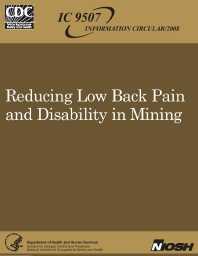Mining Publication: Reducing Low Back Pain and Disability in Mining
Original creation date: September 2008
This report was written in an effort to provide better control measures for low back pain (LBP) and low back disability in the mining industry. There are numerous factors associated with development of LBP, many of which can be effectively controlled while some cannot. Better job design is promoted as the best method of reducing cases of LBP and can also reduce the disability (i.e., lost time from work) associated with LBP when it happens. The report draws attention to what is currently known about LBP, what the causes are thought to be, and discusses recent back injury trends in the mining industry. Research describing unique physical demands in mining, such as the capabilities and limitations of working in awkward postures, is also presented. Methods that can be used to prevent initial LBP episodes are provided, including facilities design and layout for materials and supplies, use of mechanical-assist devices, improved design of lifting tasks, and better seat design. Methods of reducing the disability associated with LBP (including workplace design, proactive return-to-work efforts, communication, and management commitment) are also discussed. The report concludes that control of LBP and disability in mining requires a comprehensive approach to limit the repetitive loading that can occur on the low back due to manual materials-handling tasks and exposure to whole-body vibration (WBV). Specific recommendations include the following: 1. Successful LBP prevention efforts require a proactive program that has strong management commitment and incorporates employee involvement. 2. More efficient supply handling systems and use of mechanical-assist devices can greatly reduce exposure to hazardous lifting tasks. 3. Lifting tasks should be designed to minimize low back stress. Tools to evaluate and redesign lifting tasks are presented. 4. Improved seat design can reduce exposure to WBV and improve posture, leading to reduced LBP risk. 5. The disability associated with LBP can be reduced. Getting the worker back on the job as quickly as possible is in the interest of everyone involved.
Authors: S Gallagher
Information Circular - September 2008
NIOSHTIC2 Number: 20034645
Pittsburgh, PA: U.S. Department of Health and Human Services, Public Health Service, Centers for Disease Control and Prevention, National Institute for Occupational Safety and Health, DHHS (NIOSH) Publication No. 2008-135, Information Circular 9507 2008 Sep; :1-76
See Also
- Age Awareness Training for Miners
- An Approach to Identify Jobs for Ergonomic Analysis
- A Comparison of Fatigue Failure Responses of Old Versus Middle-Aged Lumbar Motion Segments in Simulated Flexed Lifting
- Ergonomic Interventions at Unimin
- Manual Materials Handling
- Nature and Cost of Low Back Pain
- Physical Limitations and Musculoskeletal Complaints Associated With Work in Unusual or Restricted Postures: A Literature Review
- Physical Strength Assessment in Ergonomics
- Practical Demonstrations of Ergonomic Principles
- Underground Mine Communications
- Using Ergonomics To Enhance Safe Production At a Surface Coal Mine - A Case Study With Powder Crews
- Content source: National Institute for Occupational Safety and Health, Mining Program


 ShareCompartir
ShareCompartir
